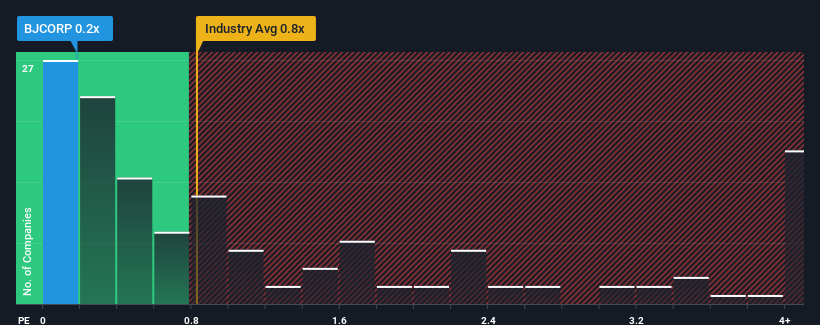- Malaysia
- /
- Industrials
- /
- KLSE:BJCORP
Revenues Working Against Berjaya Corporation Berhad's (KLSE:BJCORP) Share Price Following 27% Dive

The Berjaya Corporation Berhad (KLSE:BJCORP) share price has softened a substantial 27% over the previous 30 days, handing back much of the gains the stock has made lately. Indeed, the recent drop has reduced its annual gain to a relatively sedate 8.8% over the last twelve months.
Following the heavy fall in price, Berjaya Corporation Berhad's price-to-sales (or "P/S") ratio of 0.2x might make it look like a buy right now compared to the Industrials industry in Malaysia, where around half of the companies have P/S ratios above 0.9x and even P/S above 3x are quite common. However, the P/S might be low for a reason and it requires further investigation to determine if it's justified.
See our latest analysis for Berjaya Corporation Berhad

How Berjaya Corporation Berhad Has Been Performing
Revenue has risen at a steady rate over the last year for Berjaya Corporation Berhad, which is generally not a bad outcome. Perhaps the market believes the recent revenue performance might fall short of industry figures in the near future, leading to a reduced P/S. If that doesn't eventuate, then existing shareholders may have reason to be optimistic about the future direction of the share price.
Want the full picture on earnings, revenue and cash flow for the company? Then our free report on Berjaya Corporation Berhad will help you shine a light on its historical performance.What Are Revenue Growth Metrics Telling Us About The Low P/S?
There's an inherent assumption that a company should underperform the industry for P/S ratios like Berjaya Corporation Berhad's to be considered reasonable.
Taking a look back first, we see that the company managed to grow revenues by a handy 4.5% last year. Pleasingly, revenue has also lifted 35% in aggregate from three years ago, partly thanks to the last 12 months of growth. So we can start by confirming that the company has done a great job of growing revenues over that time.
This is in contrast to the rest of the industry, which is expected to grow by 64% over the next year, materially higher than the company's recent medium-term annualised growth rates.
With this information, we can see why Berjaya Corporation Berhad is trading at a P/S lower than the industry. Apparently many shareholders weren't comfortable holding on to something they believe will continue to trail the wider industry.
What Does Berjaya Corporation Berhad's P/S Mean For Investors?
The southerly movements of Berjaya Corporation Berhad's shares means its P/S is now sitting at a pretty low level. Typically, we'd caution against reading too much into price-to-sales ratios when settling on investment decisions, though it can reveal plenty about what other market participants think about the company.
As we suspected, our examination of Berjaya Corporation Berhad revealed its three-year revenue trends are contributing to its low P/S, given they look worse than current industry expectations. Right now shareholders are accepting the low P/S as they concede future revenue probably won't provide any pleasant surprises. If recent medium-term revenue trends continue, it's hard to see the share price experience a reversal of fortunes anytime soon.
Don't forget that there may be other risks. For instance, we've identified 3 warning signs for Berjaya Corporation Berhad (1 makes us a bit uncomfortable) you should be aware of.
If these risks are making you reconsider your opinion on Berjaya Corporation Berhad, explore our interactive list of high quality stocks to get an idea of what else is out there.
Valuation is complex, but we're here to simplify it.
Discover if Berjaya Corporation Berhad might be undervalued or overvalued with our detailed analysis, featuring fair value estimates, potential risks, dividends, insider trades, and its financial condition.
Access Free AnalysisHave feedback on this article? Concerned about the content? Get in touch with us directly. Alternatively, email editorial-team (at) simplywallst.com.
This article by Simply Wall St is general in nature. We provide commentary based on historical data and analyst forecasts only using an unbiased methodology and our articles are not intended to be financial advice. It does not constitute a recommendation to buy or sell any stock, and does not take account of your objectives, or your financial situation. We aim to bring you long-term focused analysis driven by fundamental data. Note that our analysis may not factor in the latest price-sensitive company announcements or qualitative material. Simply Wall St has no position in any stocks mentioned.
About KLSE:BJCORP
Berjaya Corporation Berhad
Provides consumer marketing, direct selling, and retailing services.
Low and slightly overvalued.

